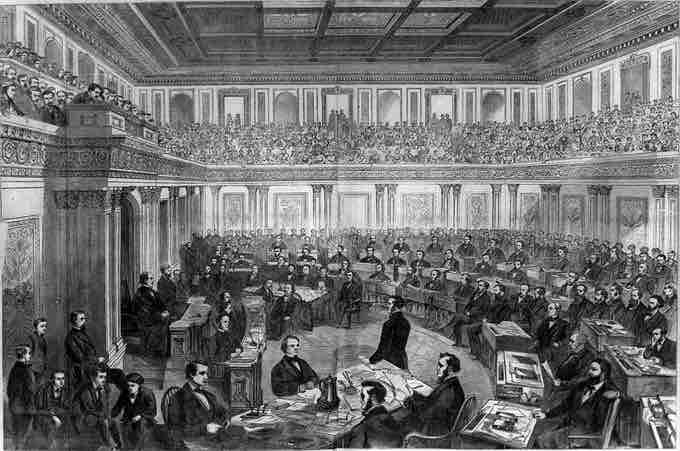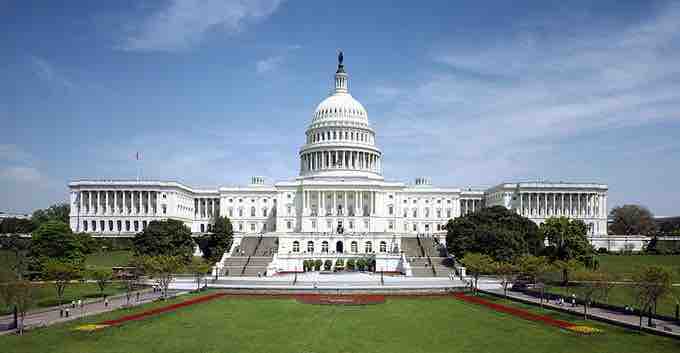The United States Constitution
The United States Constitution consists of a preamble, seven original articles, twenty-seven amendments, and a paragraph certifying its enactment by the constitutional convention. Article I of the United States Constitution describes the powers of Congress, the legislative branch of the federal government. To establish the powers of and limitations of the Congress, the Article addresses the creation of the House of Representatives, which is composed of Representatives from each state. The number of representatives for each state is dependent upon the size of the population. The Article also establishes that there will be two Senators from each state.
Joint Session of a Two-Party Congress
The United States Congress is an example of a two-party system of governance. In this picture, Obama's Health Care Speech is being given to both the House and the Senate.
The House and Senate are equal partners in the legislative process—legislation cannot be enacted without the consent of both chambers. However, the Constitution grants each chamber some unique powers. The Senate ratifies treaties and approves presidential appointments, while the House of Representatives initiates revenue-raising bills. The House initiates impeachment cases, while the Senate decides impeachment cases. A two-thirds vote of the Senate is required before an impeached person can be forcibly removed from office.

Johnson's Impeachment
The Senate functioning as the Court of Impeachment for the Trial of Andrew Johnson.
Powers of Congress
Congress has authority over financial and budgetary policy through the enumerated power to lay and collect taxes, duties, imposts and excises, to pay the debts and provide for the common defense and general welfare of the United States. Moreover, Congress has an important role in national defense, including the exclusive power to declare war, to raise and maintain the armed forces, and to make rules for the military. Congress can establish post offices and post roads, issue patents and copyrights, fix standards of weights and measures, and establish Courts inferior to the Supreme Court.
One of Congress' foremost non-legislative functions is the power to investigate and oversee the executive branch. Congressional oversight is usually delegated to committees and is facilitated by Congress' subpoena power. A good historical example of Congressional Oversight was the investigation of President Richard Nixon and Watergate.
The Executive branch and political parties and major sources of legislation. For example, the President can use his power to hand a member of Congress the content of a major bill to introduce in the house. Another souce of legislation are Courts. Judges and Justies make law everytime they struckdown laws and provide the new precedent for future legislation. The only institutions that are not sources for legislative ideas are government departments and agencies.
The House of Representatives
The United States House of Representatives is one of the two houses in the United States Congress. The major power of the House is to pass federal legislation that affects the entire country, although its bills must also be passed by the Senate and further agreed to by the President before becoming law. The House has several exclusive powers: the power to initiate revenue bills, to impeach officials, and to elect the U.S. President in case there is no majority in the Electoral College.
Each state is represented in the House in proportion to its population, but is entitled to at least one representative. The most populous state, California, currently has 53 representatives. The total number of voting representatives is fixed by law at 435. Each representative serves for a two-year term. The Speaker of the United States House of Representatives, who presides over the chamber, is elected by the members of the House, and is therefore traditionally the leader of the House Democratic Caucus or the House Republican Conference, whichever of the two Congressional Membership Organizations has more voting members.
Elections for representatives are held in every even-numbered year, and on Election Day, the first Tuesday after the first Monday in November. By law, Representatives must be elected from single-member districts by plurality voting.
The Senate
The composition and powers of the Senate are established in Article I of the U.S. Constitution. Each state is represented by two senators, regardless of population. Senators serve staggered six-year terms. The chamber of the United States Senate is located in the north wing of the Capitol, in Washington, D.C., the national capital.

U.S. Capitol
This is an image of the western front of the United States Capitol. The Neoclassical style building is located in Washington, D.C., on top of Capitol Hill at the east end of the National Mall. The Capitol was designated a National Historic Landmark in 1960.
The Senate has several exclusive powers not granted to the House, including consenting to treaties as a precondition to their ratification. The Senate also confirms appointments of Cabinet secretaries, federal judges, other federal executive officials, military officers, regulatory officials, ambassadors, and other federal uniformed officers, as well as trial of federal officials impeached by the House. The Vice President of the United States is the ex officio President of the Senate, with authority to preside over the Senate's sessions, although he can vote only to break a tie.
Senators are regarded as more prominent political figures than members of the House of Representatives because there are fewer of them, and because they serve for longer terms, usually represent larger constituencies.